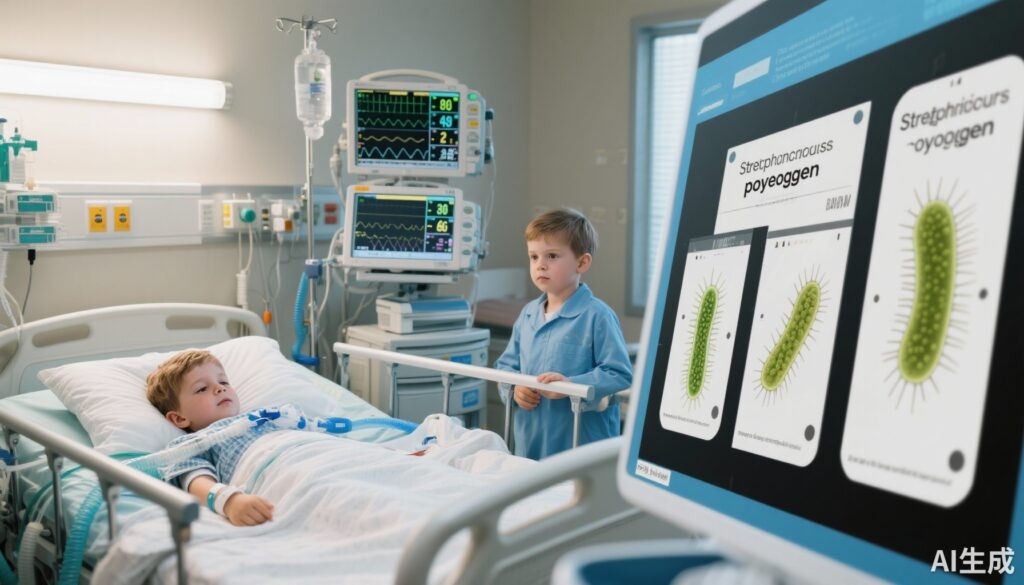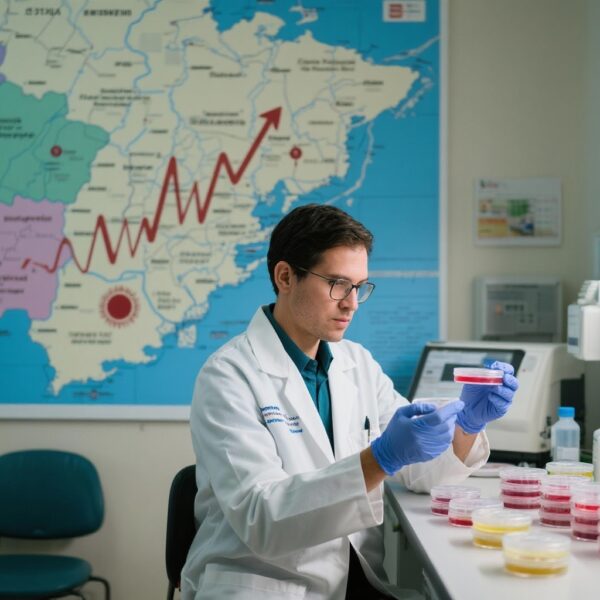Highlight
– Post-COVID-19 period shows a nearly threefold increase in pediatric invasive group A streptococcus (iGAS) incidence and heightened disease severity.
– Key risk factors for severe iGAS in children include pulmonary involvement, streptococcal toxic shock syndrome (STSS), meningitis or encephalitis, reduced consciousness, respiratory distress, elevated C-reactive protein, and decreased renal function.
– Intensive care admission and mortality rates were significantly higher post-pandemic, underscoring evolving disease burden and clinical challenges.
Study Background
Invasive group A streptococcal disease represents a spectrum of infections caused by Streptococcus pyogenes, ranging from mild local infections to life-threatening invasive conditions such as necrotizing fasciitis, streptococcal toxic shock syndrome, pneumonia, and central nervous system infections. Pediatric populations are particularly vulnerable due to their developing immune systems. In the Netherlands, a notable surge in pediatric iGAS cases was observed starting early 2022, raising clinical and public health concerns. The COVID-19 pandemic, associated with widespread behavioral changes and healthcare disruptions, appeared to influence the epidemiology and severity of iGAS. Understanding risk factors for severe disease and temporal incidence trends is critical for guiding management strategies and prioritizing healthcare resources.
Study Design
This large-scale observational cohort study combined retrospective data collection (January 2015 to March 2020) with prospective, real-time reporting (January 2022 to June 2024) across 20 hospitals in the Netherlands, including tertiary and nontertiary centers. It included children aged 0 to 17 years with confirmed invasive group A streptococcal infection, diagnosed through culture, polymerase chain reaction, and/or consistent clinical presentation. The study classified periods into pre-COVID-19 (2015–March 2020), COVID-19 pandemic (April 2020–December 2021), and post-COVID-19 pandemic (January 2022–June 2024) to assess incidence and severity changes over time. The primary outcome was identification of risk factors associated with severe disease, defined as requiring intensive care unit (ICU) admission and/or resulting in death. Secondary outcomes included incidence rate changes and clinical phenotype distributions across time periods. Statistical analyses incorporated univariable and multivariable logistic regression to evaluate risk factors and Poisson regression to calculate incidence rate ratios (IRRs).
Key Findings
Overall, 617 pediatric iGAS cases were included, with more than half (56.9%) occurring in children aged 0–4 years. Among the subset of 192 cases with detailed clinical data, the median age was 4.2 years, and nearly half were male. The study found that iGAS cases significantly declined during the COVID-19 pandemic compared to the pre-pandemic era but surged markedly post-pandemic, with an IRR of 2.93 (95% CI, 2.46–3.49) relative to pre-COVID-19 levels. By late 2023, incidence rates returned toward baseline pre-pandemic values.
Severity of iGAS increased in the post-pandemic period. Mortality was higher (4.4% vs 1.4%) and ICU admissions more frequent (38.4% vs 15.6%) post-pandemic compared to pre-pandemic, indicating a more complicated clinical course. Surprisingly, severity of pulmonary iGAS infections did not significantly differ between these periods.
Important risk factors associated with severe outcomes included:
– Post-pandemic diagnosis (adjusted odds ratio [OR], 3.49; 95% CI, 2.31–6.26),
– Pulmonary involvement (OR, 8.64; 95% CI, 5.50–13.55),
– Streptococcal toxic shock syndrome (STSS) (OR, 11.71; 95% CI, 4.39–31.18),
– Meningitis or encephalitis (OR, 4.38; 95% CI, 1.84–34.41).
Clinical signs associated with severity included reduced consciousness (OR, 7.61), dyspnea (OR, 9.89), abnormal lung auscultation findings (OR, 6.32), and elevated C-reactive protein levels (OR, 6.32). In contrast, higher estimated glomerular filtration rate (eGFR) was protective (OR, 0.64).
The post-pandemic period also featured striking increases in specific clinical phenotypes, including pulmonary infections (IRR, 5.04), STSS (IRR, 10.30), meningitis or encephalitis (IRR, 12.30), and necrotizing fasciitis (IRR, 26.10). These data indicate not only a resurgence in iGAS incidence but also a shift toward more aggressive and invasive disease forms.
Expert Commentary
This extensive Netherlands cohort study furnishes critical epidemiological and clinical insights into pediatric iGAS dynamics influenced by the COVID-19 pandemic. The observed post-pandemic surge and heightened severity might reflect altered host-pathogen interactions, population immunity fluctuations, or changes in healthcare-seeking behavior during and after pandemic restrictions. The strong association of severe disease with central nervous system involvement and STSS aligns with the known pathophysiology of invasive group A streptococcal disease. The significant role of elevated inflammatory markers such as CRP highlights the importance of prompt clinical assessment and may provide surrogate markers for disease progression.
Limitations include the observational design, potential underreporting during the pandemic due to healthcare access issues, and incomplete demographic or socioeconomic data which could influence severity risk. Furthermore, the study is geographically limited to the Netherlands; however, its findings likely resonate in similar healthcare settings and underscore the need for vigilance globally. Additional research to explore host immune responses, bacterial strain virulence factors, and vaccine or prophylactic strategies is warranted.
Conclusion
This comprehensive study identifies a constellation of clinical and temporal risk factors that enhance the risk of severe invasive group A streptococcal disease in children. Post-COVID-19 pandemic periods were marked by increased incidence and severity, with pulmonary and central nervous system involvement, STSS, respiratory distress, elevated inflammation markers, and renal function metrics playing pivotal roles. Awareness of these parameters can facilitate early identification and targeted interventions to reduce morbidity and mortality. Continued surveillance and research efforts are essential to prepare healthcare systems for fluctuating infectious disease patterns and to inform evidence-based clinical guidelines.
Funding and ClinicalTrials.gov
The study as reported does not specify funding sources or clinical trial registration numbers. Further details can be obtained from the original publication.
References
van Kempen EB, Tulling AJ, von Asmuth EGJ, et al. Risk Factors for Severe Pediatric Invasive Group A Streptococcal Disease. JAMA Netw Open. 2025;8(8):e2527717. doi:10.1001/jamanetworkopen.2025.27717. PMID: 40828532; PMCID: PMC12365701.



